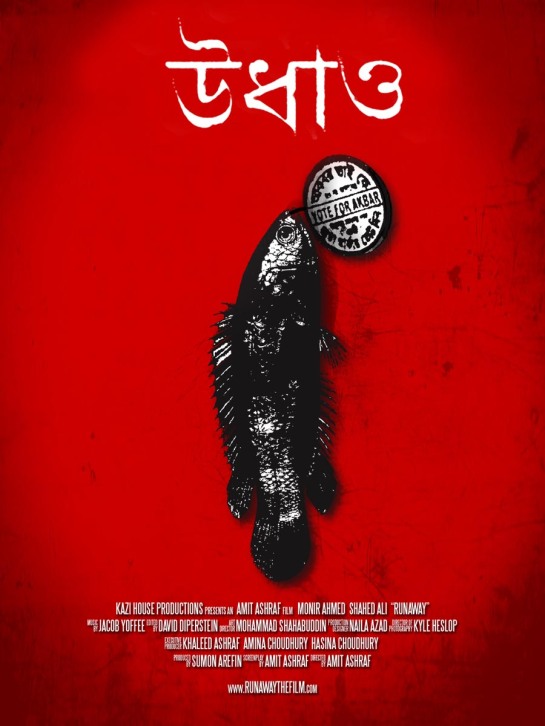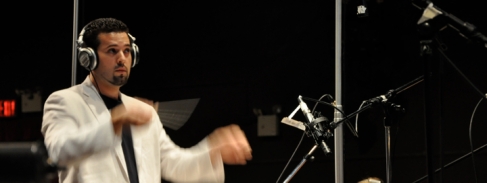
Mock poster design by Inshra Russell. Tell us what you think?


Mock poster design by Inshra Russell. Tell us what you think?
While editing Udhao, I naturally tried to approach the process in a collaborative way with Director Amit Ashraf as I am not a native Bangla speaker. This presented some unique challenges in perfecting the ever important timing of dialogue that is critical to keeping the audience’s attention. By working together most of the time we were able to develop a rhythm which allowed Amit and I to explore new avenues within the storytelling. As the film shaped up, it was clear that the genre lines were starting to blur. Intense sequences of action were surrounded by serious dialogue or lighthearted family moments. The climax of the film itself is an extraordinarily difficult scene to digest as it deals in multiple timelines and stylized portrayals of inner motivations. To bring comprehension to this important sequence required a significant amount of strategy in laying the groundwork earlier on for these later scenes. We discussed techniques which would be applied later including musical cues via certain instrumental patterns in the soundtrack and color palettes that would be unique to different moods.
Looking at the footage as a whole I realized that the story couldn’t be told chronologically. The magic of the reveals would be lost if we could trace the pattern in the timing. This left me with a bit of a quandary in finding the moments which could be held back just enough so as to create an heir of mystery rather than raise questions which demanded answers. Knowing this was the strategy that I wanted to pursue, I then found myself staring at the footage uncertain of the exact avenue on which to proceed.
When faced with an ‘Editor’s Block’, I always work deductively. I put the pieces in place which are 95% inviolable and then assume they are carved in stone for that cut. I then look at what’s left, often separating myself from the story entirely, so as to ask myself what can be readded in a way that best serves the footage I’m staring at. In this film, as is usually the case, I put together an ending and started editing towards the beginning.
With Udhao, Amit was prepared to allow full flexibility in completing the film. He knew he had done his job with the actors and DP Kyle Heslop had done his job lensing the piece. What was left was having foresight into what the final product would look like now that all of the footage could be viewed as a collection. What was there for the audience to work with? With every shot we asked ourselves how it held up in the frame relative to the prior and ensuing shot from an aesthetic perspective. This was vital as the color palette would often jump from light to dark or back again. Would the audience be able to make out the details in a dark theater or be blinded? Would they retain certain quick, key flashback moments? Then we realized that some acts were so powerful others lagged behind and the film needed a restructure. Putting the ending in place we explored alternatives for several months before finding a ‘special sauce’ that let the film honor it’s original script while being uniquely new at the same time.
We did this by building the skeleton with those plot moments which were written in stone and then struck the best balance between the continuity of the story as it existed and the new continuity we were developing. Ever so slightly different, but nearly the same. We then used the power of non-linear editing to shuffle around scenes to see how they played in the multi-timeline chronology we were developing. It was paramount to consistently question individual takes on their merit as we constructed this new story and found ourselves with the common task of reducing the film down to a manageable runtime.
One of the more unique challenges of the film fell in resolving issues that came about from a split production schedule. Because of the nature of indie film, budgets are often severely tight. Fortunately, Amit’s vision was nowhere near as humble as the average indie director and he refused to compromise when it came to getting the story told in his way. As a result of this, the filming was split in half and this required obtaining various production gear that was available when the production could resume, a bit of a trick in a developing country. So the film was acquired on a number of digital formats that each presented their own unique issues when combined in the editorial process and required some clever manipulation to make them all fall into a compatible pattern on a budget. The result of this was a bit of a hodgepodge of ensuing post production issues, at the price of a superior story.
As a result of careful planning of the post production phase and schedule we were able to hedge on other facets of post to cover for the inevitable missteps that occur which editing can not cover. Usually these are no big deal for larger Hollywood films, however working on an indie budget required extensive strategy sessions for every decision that was made and a bit of risk in making each choice. This included the decision to spend a significant portion of the limited post budget on an orchestral score, proper sound mix, and expert sound design. Working in partnership with composer Jacob Yoffee, we were able to go back and tweak certain key moments to allow the music and image to work together more harmoniously. Having partnered with him to develop key sounds throughout the editing of the film we were able to maintain the pacing we wanted with minimal revisions when we got to the scoring phase. This resulted in a knockout soundtrack that worked perfectly with the editing timing of the film.
From a picture cutting perspective, the back and forth may sound like a lot of additional work, but instead it felt like an ongoing dialogue. There were never circular discussions concerning merits of different ideals as we committed to a common idea before pushing any buttons and were agile to experiment when not in agreement. This led to a fluid conversation that facilitated an edit exponentially more polished and watchable than had Amit not had the foresight to deviate from his original game plan.
ROUGH CONCEPT TRACKS that didnt make it into the film, but still badass!
The process of developing the music for the film is as important and grueling as shooting it. Sound is half of the experience and big part of building the emotions. Director Amit Ashraf worked closely with composer Jacob Yoffee while the film was still in production. After seeing a rough cut together, the two discussed types of existing music that would be good references. Some of the inspirations are drawn from composers such as Ennio Morricone (The Good, The Bad and the Ugly), Gustavo Santaolalla (official)(Motorcycle Diaries), Clint Mansell Composer (Requiem for a Dream) and Bangla music. After temping the whole film with existing music that fit the theme and soundscape Amit envisioned, Jacob came up with rough drafts of original themes for Amit to choose from. Below are examples of five options for the main theme of Runaway (Udhao). They are unproduced, MIDI versions, created completely on the computer. Without live musicians its missing a little life, but they are definitely still badass and any of them are worthy of being in a film. Can you tell which one was ultimately chosen to be developed into Runaway’s theme?
https://soundcloud.com/runawaysoundtrack/sets/runaway-udhao-concept-tracks

Working with DirectorAmit Ashraf on the score for ‘Udhao’ was an extremely collaborative process. As in the case for many independent productions we spent a much longer period of time talking and sculpting ideas than you would normally get for larger ‘Studio’ productions. We developed the music over the course of a year and half and held nine different recording sessions to complete the entire score.
In the beginning we went back and forth discussing influences, both filmic and musical, for the world we were to create. It boiled down to an ‘East meets West’ sound that allowed for familiar Hollywood-style scoring techniques and the use of strings (violins, cellos, etc….) but also required Eastern instruments. He sent me thirty-five CD’s to study to acquaint myself with the sound of Bengali instruments and more traditional music. And on top of that there was a modern ‘Spaghetti-Western’ element needed, so we filled everything with loud, grungy guitars that were run through lots of distortion and tremolo. The result was always an experiment and there was a kind of trial-and-error process we developed to get the right sound for many cues in the film.
As for the traditional music I spent a few weeks listening and transcribing traditional folk songs to try to understand the difference between Bengali music and North Indian music or Middle Eastern music, for instance. A big concern was that it would sound insincere if the Bengali element were slapped on like seasonings in a recipe, rather than the initial ingredients. There are parts of the film where we opted to use folk songs in places to pay homage to the tradition rather than writing original music.
All in all I think the film is a genre-bending venture (not a period piece or a snapshot of Bengali culture) and we were able to focus on creating something new and unique. I absolutely loved the collaborative back and forth with Amit as new picture edits were made, new footage came in. It was wonderful to see the story unfold and grow as each element of the project was put into place.
Website: www.jacobyoffeemusic.com
https://soundcloud.com/runawaysoundtrack/12-journey-home
Check out music from our soundtrack, releasing soon. A unique mix of Wild West meets Bangla music. Composed, orchestrated and mastered in Hollywood.
For our facebook link please visit http://www.facebook.com/RunawayTheFilm which goes by our international title: Runaway.
Synopsis
“Like Tarantino met Satyajit Ray in Dhaka and made a movie!”
A fast-paced thriller about the men who hide in the shadows of Dhaka city, and a rickshawalla turned bounty hunter named Babu hell-bent on finding these runaways and forcing them to face their past. His life’s mission comes to an ultimate crossroad when he meets his biggest prey: a corrupt politician named Akbar. Convinced an evil spirit possess him, Babu captures Akbar and forces him to retrace the winding path that led him to the city. Little does Babu know the dark secrets that haunt Akbar are about to be unleashed…